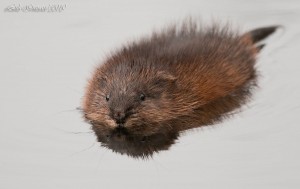Muskrat
Muskrat: Photo by Luke Ormand
The muskrat (Ondatra zibethicus) is found throughout Kansas. It is a large semi-aqautic rodent that lives near slow moving streams, marshes or ponds. They dig entrances into the banks along these waterways to three-feet tall push-ups composed of vegetation and mud. They can remain underwater for fifteen minutes. Muskrats are protected from cold water by a thick fur consisting of two layers of hair. Their tail is flattened vertically. They are smaller than beavers with whom they share an environment and amicable relationship. Muskrats are most active at night but also near dawn and dusk. Muskrats mostly eat cattails, bur reed and other aquatic vegetation like water lily. Because of their eating habits, they play a significant role in determining the vegetation of prairie wetlands. They don’t store food for the winter. They also occasionally eat freshwater mussels, frogs, clams, snails, crayfish, fish, and small turtles. Large hawks and owls, foxes, coyotes and mink prey upon muskrats. Pike may take baby muskrats. Muskrats normally live in groups consisting of a male and female and their young. During the spring, muskrats may fight over preferred territory and potential mates.

